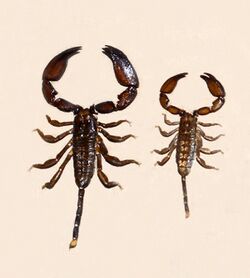Biology:Liocheles australasiae
| Liocheles australasiae | |
|---|---|

| |
| Liocheles australasiae from Enggano Island. Museum specimens | |
| Scientific classification | |
| Kingdom: | |
| Phylum: | |
| Class: | |
| Order: | Scorpiones
|
| Family: | |
| Genus: | |
| Species: | L. australasiae
|
| Binomial name | |
| Liocheles australasiae (Fabricius, 1775)
| |
| Synonyms | |
| |
Liocheles australasiae, the dwarf wood scorpion, is a species of scorpion belonging to the family Hormuridae.[1][2][3][4]
Distribution
This species is present in India , Sri Lanka, Bangladesh, Yaeyama Islands (Japan), China , Thailand, Vietnam, Malaysia, Philippines , Taiwan, Mariana Islands, Indonesia, Australia , Papua New Guinea, Solomon Islands, New Caledonia, Fiji, Tonga, Samoa and French Polynesia.[5][6]
Description
This small scorpion has the total length of 22 to 36 mm. Patella of pedipalps with 3 ventral trichobothria. Body uniformly reddish to yellowish brown. Telson yellow. Median and three lateral pigmented eyes present, which are not troglobitic. Chelicerae are yellowish brown, and reticulated. Carapace without carinae. but punctate and bears a straight median longitudinal groove. There are 4 to 8 pectinal teeth. Metasomal segments are sparsely setose and finely punctate. Pedipalps also covered by granules. Ventrum of pedipalp is punctate. In males, the fingers of chela are conspicuously flexed.[6][7]
Most of the populations are parthenogenetic, where they can produce young without males.[8] In Sri Lanka, three females were discovered from Bentota, Galle, without a male, but all specimens were females or juveniles. Specimens are observed inside a stone wall and under old bark of branches and also in dry leaves and under the flower pots in home garden.[6]
Bibliography
- Yamazaki K, Yahata H, Kobayashi N, Makioka T. Egg maturation and parthenogenetic recovery of diploidy in the scorpion Liocheles australasiae (Fabricius) (Scorpions, ischnuridae).
- TOSHIKI MAKIOKA Reproductive biology of the viviparous scorpion, Liocheles australasiae (Fabricius) (Arachnida, Scorpiones, Ischnuridae) IV. Pregnancy in females isolated from infancy, with notes on juvenile stage duration
- Fabricius, 1775 : Systema entomologiae, sistens insectorum classes, ordines, genera, species, adiectis, synonymis, locis descriptionibus observationibus. Flensburg and Lipsiae.
- Monod, 2011 : Taxonomic emendations in the genus Liocheles Sundevall, 1833 (Scorpiones, Liochelidae). Revue Suisse de Zoologie, vol. 118, no 4, p. 723-758.
See also
- Lesser brown scorpion
References
- ↑ Biolib
- ↑ Goonathilake, Chamod (2020-07-21). "Introduction to Scorpions of Sri Lanka" (in en-US). https://teamwildfreaks.com/introduction-to-scorpions-of-sri-lanka/.
- ↑ Malsawmdawngliana, Fanai; Vabeireiryulai, Mathipi; Malsawmdawngzuali, Tara; Biakzuala, Lal; Tochhawng, Lalengzuala; Lalremsanga, Hmar Tlawmte (2021). "A new record of Liocheles australasiae (Fabricius, 1775) (Scorpiones: Hormuridae) from the state of Mizoram, India". Journal of Animal Diversity 3: 11–17. doi:10.52547/JAD.2021.3.1.3.
- ↑ "The Scorpion Files - Liocheles waigiensis (Ischnuridae)". https://www.ntnu.no/ub/scorpion-files/l_australasiae.php.
- ↑ Australian faunal directory
- ↑ 6.0 6.1 6.2 Charles University; Kovařík, František; Ranawana, Kithsiri B.; University of Peradeniya; Jayarathne, V. A. Sanjeewa; University of Peradeniya; Karunarathna, Sanjaya; University of Peradeniya et al. (2018). "Scorpions of Sri Lanka (Arachnida, Scorpiones). Part II. Family Hormuridae". Euscorpius 2018 (258): 1–5. doi:10.18590/euscorpius.2018.vol2018.iss258.1. https://mds.marshall.edu/euscorpius/vol2018/iss258/1/. Retrieved 2021-08-31.
- ↑ "Habitat characteristics of two scorpion species, Liocheles australasiae (Fabricius, 1775) and Isometrus maculatus (De Geer, 1778) in Miyako Islands, Japan". https://mds.marshall.edu/cgi/viewcontent.cgi?article=1364&context=euscorpius.
- ↑ Yamazaki, Kazunori; Makioka, Toshiki (2005). "Parthenogenesis through Five Generations in the Scorpion Liocheles australasiae (Fabricius 1775) (Scorpiones, Ischnuridae)". The Journal of Arachnology 33 (3): 852–856. doi:10.1636/S02-5.1. https://www.biodiversitylibrary.org/partpdf/228897. Retrieved 2021-08-31.
Wikidata ☰ Q3241745 entry
 |


